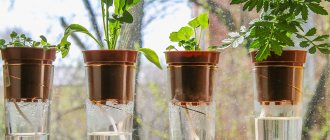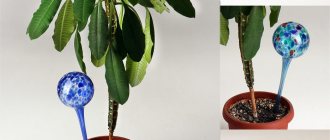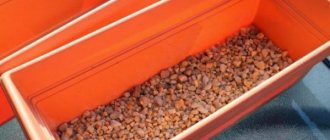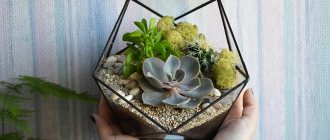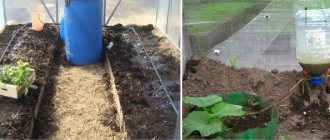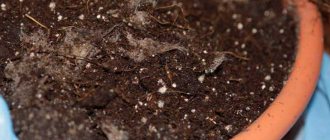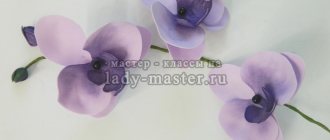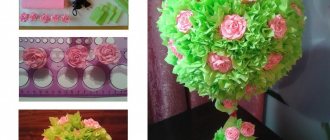Proper watering of Saintpaulias is a prerequisite for their cultivation. Each violet lover uses trial and error to select the optimal method of irrigating plants. Among experienced gardeners, wick watering of violets is very popular. It reduces the time required to care for a large collection of flowers, takes into account the individual watering needs of plants, and allows you to leave home for a while, for example, to go on vacation.
Using watering through a wick, plants are automatically irrigated without requiring constant human presence. To equip it, you do not need to install a complex system or purchase devices and mechanisms.
The essence of the method of watering violets using the wick method
Wick watering is a method that makes the life of gardeners much easier, since these plants do not really like top watering. Using the traditional method, you can flood the flower, and water will get on the leaves, and violets absolutely cannot tolerate this. Therefore, wick watering is ideal for them. Its essence lies in the fact that with the help of a special wick or cord that extends from the soil at the bottom of the pot, the plants immediately receive moisture from the vessel below. This way they can take only the amount of water they need.
Violets on wicks
Preparatory stage
At the preparation stage, you need to stock up on a pot, filler and wick.
Potty requirements
Flower growers recommend giving preference to pots and water containers that are made of plastic; the diameter of the upper rim does not exceed 8 cm. The material is easy to wash and disinfect. It is easy to make a hole of the required size in the bottom part.
Reference! Plastic cups, bottles and containers are suitable for organizing wick watering.
When placing small pots on a common tray of water, you need to place a grate on the bottom so that the containers do not touch the water.
Suitable soil
For unhindered water to rise through the wick, you need a substrate that has high breathability and the ability to retain a moist environment. The mixture for filling the pot includes:
- vermiculite;
- perlite;
- sphagnum moss;
- peat and other components.
Mixture option: one part each of perlite, vermiculite and peat. The prepared soil is poor in nutrients, so regular fertilizing should be provided.
Pros and cons of converting Saintpaulias to wick irrigation
Advantages of transferring violets to wick watering:
- Providing better conditions for the growth and development of violets - flowering will begin earlier and last longer.
- No need for individual watering.
- If you choose the right proportions of water and fertilizer, there will be no oversaturation or lack of necessary substances.
- The florist can not worry about the condition of the Saintpaulias for quite a long time and can calmly go on vacation.
- The plant cannot be overwatered, since it will take the required amount of water on its own.
- Mini and micro violets grow well only on a wick.
- The smaller the diameter of the pot, the more intensively the violet develops.
DIY drip irrigation for indoor plants
Reasons why you should not switch plants to wick watering:
- If the wick is incorrectly selected, the root system may become oversaturated with moisture, causing the roots to rot.
- With this method of watering, leaf rosettes become larger and therefore take up more space.
- In winter, it is better not to keep violets watered in this way on the windowsill, as the water may become supercooled.
Important! This method has much fewer disadvantages than advantages. Even if you give up wick watering for a while, for example, in the cold season, you can always switch your violets to it again.
Advantages and disadvantages of the method
Amateur flower growers who have used wick irrigation for violets express conflicting opinions about the advisability of its use. This is due to the fact that the method has not only advantages, but also disadvantages. Its undeniable advantages:
When planting violets on a wick, small pots are used, so the volume of soil mixture is reduced, and flowerware is cheaper.
Knowing the vulnerable points of watering plants through a wick will help reduce its possible negative consequences. The disadvantages of wick watering violets are as follows:
Converting indoor plants to wick watering may entail re-equipping flower shelves, since they must accommodate not only pots, but also containers underneath them.
Wick watering of violets: how to do it - preparation
Automatic watering for indoor plants - do it yourself
To organize proper wick watering for violets, you will need: properly prepared soil, a pot, a water container and the wick itself.
Soil preparation
When using wick irrigation, you will need loose, moisture- and breathable soil. In addition to peat, its composition must include a leavening agent - sand, perlite, moss. A good layer of drainage located under the soil layer is also necessary.
Composition of soil for violets
Important! Before planting, it is better to disinfect any type of soil with a manganese solution or special disinfectants.
Selection of containers
The flower pot should be small, but not too cramped. It is better if it is plastic - this is the lightest material that will not add weight that puts pressure on the container for watering. The container itself can be one for several pots or individual for each violet.
Advice! It is better to use large tanks, since it is easier and faster to add water and fertilizers to them.
One container for several flowers
What to make a wick for violets from
It is most convenient to use a synthetic cord as a wick, since natural fabrics will quickly rot. The selected material must absorb water well. The thickness of the wick varies and is selected individually for each pot. As a rule, a cord 5 mm thick is selected for a pot with a diameter of 5-8 cm.
Fertilizers used
Any fertilizer suitable for violets can be used. Let's look at some of them:
- Agrecol NPK 9:4:5 - during growth;
- Agrecol NPK 4:5:8 - when buds appear and flower;
- solution concentration - 0.5 ml per liter of water;
- Fertika - solution concentration: 100 g pack per 2.5 liters of water. Add to the solution during wick watering at the rate of 1 tsp. per 1 liter of solution;
- Kemira Combi - 2% concentrated solution: 20 g pack per 1 liter of water. To obtain a 0.05% solution used for wick irrigation: 5 tsp. (25 ml) per 1 liter of water.
If the plant is constantly on a solution containing fertilizer, then the concentration of the solution should be 3-4 times less than indicated in the instructions.
Growing and caring for verbena in your garden.
See photos of gatsanii flowers on our website: https://rusfermer.net/sad/tsvetochnyj-sad/vyrashhivanie-tsvetov/posadka-gatsanii-yuzhnoafrikanskoj-romashki-v-nashih-shirotah.html
How to transfer violets to wick watering: step-by-step instructions
DIY drainage for indoor plants
Obviously, wick watering for Saintpaulia is preferable to conventional watering. But you need to transfer to it, following certain rules, so as not to harm fragile plants.
Mature plants
Adult flowers can be easily transferred to wick watering. To do this you need:
- Prepare all the necessary components to carry out the process.
- Pour the previously prepared soil mixture into the pot, replant the violet using the transfer method, and pour water so that the soil becomes wet and settles.
- Drain off any remaining water that has not been absorbed and place the pot on a container with prepared warm water.
- The distance between the pot and the liquid level should be 1-2 cm.
Now the violets will not need top watering; they will receive water through the wick. Therefore, you don’t have to worry about water getting on the leaves, sunburn and overflow of flowers. By experimenting with different types of containers, you can find an option that is more convenient and beautiful.
Preparation of materials for wick irrigation
Sockets
- Prepare the necessary materials that will be used in the process of bottom watering.
- Check for a hole in the flower pot.
- Prepare the wick. For one pot you will need a cut about 20 cm long, one end of which is placed in a spiral on the bottom of the pot, and the second is placed in a vessel with water.
- A layer of sphagnum is laid on a circle laid in a spiral, which will further contribute to the potential separation of the children. A layer of prepared substrate is poured on top of the moss.
- Violet cuttings are planted. Each cutting is placed in a separate container.
- In order for young plants to be saturated with moisture, the pot must be completely immersed in a solution with a growth stimulator.
- The glasses are placed on vessels with water so that they are a couple of centimeters above the liquid level.
If everything is done correctly, the cuttings will take root in a few days. Evidence of this will be the green leaves rising up.
What does an organization need?
Wick irrigation technology uses the ability of the cord to absorb liquid from the container and saturate the soil in the flower pot with it. Plants receive the amount of moisture they need without the threat of soil waterlogging.
Wick requirements
The material used to make your own wick is a synthetic fiber cord. Natural fibers and fabrics are not used, as they rot quite quickly.
The optimal cord thickness is from 1.5 to 5 mm, length is from 15 to 20 cm.
To ensure that the chosen material is suitable for making a wick, it should be moistened with water, allowed to dry and placed back into the liquid. If the cord immediately gets wet, you can safely use it to make a wick. If it does not get wet and floats on the surface of the water, then the material is not suitable.
Before laying in the pot, the cord is pre-moistened with water.
What should the soil be like?
To set up an irrigation system through a synthetic wick, a properly selected soil mixture is of great importance. It should be breathable, light, loose. To do this, equal parts of vermiculite, peat soil and coarse perlite are added to the soil for wick irrigation.
Before mixing, perlite and vermiculite are moistened with water until slightly damp, but not wet. The resulting soil is not nutritious enough, so for lush, long-lasting flowering of the rosettes you will need high-quality fertilizing.
Selection of capacity
A flower pot is selected with a small diameter: from 7 to 11 cm. If the holes at the bottom of the container are too large and the substrate spills out through them, they are covered with a piece of synthetic fabric. No need to use clay pots. It is recommended to choose light containers, since the design is quite heavy.
As containers for water, you can purchase ready-made dishes specially designed for irrigation through a wick, or use plastic food containers. For example, 500 ml plastic disposable cups are suitable for pots with a diameter of 9 cm.
If a food-grade plastic container is used instead of a liquid reservoir, pour water into it, close it with a lid, and cut a hole in it for the cord. The pot of Saintpaulia is placed on top, the string is threaded through the hole in the lid, and then lowered into the water.
When using disposable plastic cups, lids are not needed. They are tightly covered with pots, and the solution does not evaporate. The distance between the bottom of the pot and the liquid in the glass should exceed 0.5 cm.
How often to add water to the container so as not to flood the violets
Water is added to the container as it is consumed. The lace must be constantly in the water. It is best not to allow the liquid level to drop more than 2 cm from the bottom of the pot.
In hot summer you will have to add water more often than in autumn or spring. In winter, it all depends on where the flowers will be located. If they stand next to a central heating radiator, you will have to monitor the moisture level.
Important! During a long vacation, it is worth adjusting the length of the wick, since violets do not like dry soil.
Wick watering of violets is a system that you should not be afraid of. Plants watered in this way grow faster, bloom more luxuriantly and last longer. For Saintpaulias, this type of watering is most useful, since they can consume exactly the amount of moisture and nutrients that they need. As a result, there is no need to worry about either overfilling or underfilling. The composition of the liquid in the container can be adjusted by checking the reaction of flowers to different types of fertilizers.
What should the water be like?
Violet colors
Previously, it was recommended to use melt and rain water for watering indoor flowers. Now, due to the unfavorable environment, these tips are irrelevant: such water will do more harm than good.
Another problem for violet lovers is hard water from the city water supply, which is often chlorinated. All substances settle on the soil and walls of the pot in the form of a white coating, which prevents the access of beneficial microelements to the root system.
Tap water is not suitable for watering violets
When water is boiled, most of the harmful salts decompose and form sediment, but this does not solve the problem. Boiled water needs additional acidification, for which you can use:
- acetic acid - 1 teaspoon per 1 liter of water;
- citric acid - 5 crystals per 1 liter of water.
Violets should be watered with this solution no more than once a month.
If tap water in your area is soft, leave it in an open container for 2 days. During this time, the chlorine will disappear from the liquid, and the lime will settle to the bottom. You can safely water your violets with this settled water.
In many populated areas in the spring, the concentration of chlorine in tap water increases, so in addition to settling, it requires filtration. Pass water through filters that do not contain silver. The same applies to well and river water.
Make sure the water is at room temperature
This is important no matter which watering method is chosen.
How to prepare a pot for reuse
If the owners have a large collection, it is expensive to buy new containers every time. Even when they use cheap plastic.
Old pot:
- Free from substrate and drainage residues.
- Soak for 2 hours in hot soapy water.
- Remove deposited salts with steel wool or a stiff brush.
- Pour in a sterilizing solution overnight. For example, dilute 100 ml of bleach in 2 liters of liquid.
- Rinse thoroughly with clean water.
The same is done with trays or tanks for wick irrigation.
LiveInternetLiveInternet
Anyone who has just begun to get interested in violets waters their plants in the usual way: in a tray or in the pot itself, directly under the leaves. And most often, problems that appear over time when growing violets are associated either with the earthen clod drying out or with its overflow. Because of the first, violets lose leaf turgor and drop flowers; because of the second, the roots rot and the plant may even die. And although every gardener tries to follow the watering regime, it is very difficult to take into account the individual characteristics of each outlet, the temperature and humidity in the room, as well as other nuances. So what to do? Everything is very simple: switch to wick irrigation, and you will make your life much easier, and provide your “wards” with the most comfortable conditions.
What is “wick watering”? Wick irrigation is an irrigation method that uses the capillary properties of a cord, due to which water from a container under the pot rises along the wick and releases moisture to the substrate. As soon as the substrate dries out, the water “pulls up” again. As a result, the plant receives only the amount of water that it needs at a given time under given conditions. If conditions change (it becomes hot or cold, air humidity increases or decreases, the plant grows, etc.), then the amount of incoming liquid will also change to what your violet needs.
Of course, there are some disadvantages : 1. If the system is not designed correctly and the substrate is waterlogged, the roots may rot. However, even with normal watering, this phenomenon is by no means uncommon! 2. When over-watered, small flies may appear - sciarids (fungus gnats). However, since their larvae feed on decaying organic matter (leaf soil, etc.), the chances of getting them with regular soil mixture (and, accordingly, regular watering) are much greater. 3. Some people complain that when transferred to a wick, the violets become much larger in size. This is true if you leave them in ordinary 10-12 cm pots. However, wick watering requires a smaller container, and in a 5.5-8 cm pot, violets feel comfortable, bloom profusely, but the size of the rosette remains normal! 4. Many people worry that when a container with violets is on the windowsill, the water in the trays cools down and the plants drink cold water. Yes, this is a minus. But when you water each violet separately with warm water, then on the same windowsill the moistened earthen lump instantly cools down and the roots are in the cold substrate. That is, there is no difference in this case. The only way out, regardless of the method of watering, is to either insulate the windowsill or move the violets to a warmer place during the cold period.
What are the advantages of wick watering when used correctly: 1. Violets grow in the most comfortable conditions, without experiencing stress from overwatering or drying out; 2. Having found the optimal concentration of the fertilizer solution, you will not overfeed or underfeed the violets; 3. Growing violets becomes very easy: you don’t need to check every day to see if the earth ball is dry and run around with a watering can/pear/dropper to measure out the amount of water the plant needs; 4. In winter, due to the high dryness of the air, the top layer of soil dries out, but moisture remains inside. And you can easily flood the plant. Whereas with wick watering, the substrate is wetted evenly: the top layer dries out and moisture is immediately drawn from below; 5. You can leave violets for a long time (several weeks), for example, during vacation, and not ask your neighbor/friend/mother to water your pets; 6. It is very easy to root and grow a large number of violets, since you do not have to water each pot separately; 7. If it comes to rooting leaf cuttings, then you will not miss the moment of evaporation of water from the glass (also very important with a large number of violets); 8. Thanks to comfortable conditions, violets not only bloom more luxuriantly, but also bloom much earlier;
9. Violets love high air humidity, but it is quite difficult to provide it without special humidifiers. But with wick watering, water will constantly evaporate little by little from the reservoirs with the solution, which will create additional humidity in the air near the plant; 10. Mini-violets, which are grown in very small pots, can dry out literally within a day with normal watering, so wick watering is very convenient when growing them; 11. Since the food will come from the solution, and not from the soil, the pot needs to be small (even less than 1/3 of the diameter of the outlet), and this means a certain saving both on the amount of substrate and on the pots themselves (the larger the diameter, the higher the price); 12. With a small diameter of the pot, the rosette is small, but evenly developed. Energy is spent on flowering, and not on gaining green mass; 13. As a result, you will get healthy, well-developed, abundantly blooming violets, since with wick watering the plants receive all the necessary microelements from the solution, and the violet regulates the level of soil moisture itself.
We have been using wick watering since 2005 and have noticed that violets have begun to grow much better than when watered in a tray. Their leaves are clean (without traces of drops, which are almost inevitable with normal watering), and the head of flowers is much larger and denser.
How to organize such a wonderful system? Let's consider two examples - rooting leaf cuttings in sphagnum moss using wick irrigation and growing children and adult plants using wick irrigation. For both of them there are 3 common points : the wick, the solution and the container for wick watering.
The wick must be synthetic (cotton will rot very quickly) and be well wetted, that is, have capillary properties. This is a very important point, since not all synthetic cords are hygroscopic, so it is advisable to check this in advance (you can ask them to wet a small area right in the store). We cut the wick into pieces about 20 cm long. The thickness of the wick is usually small. For pots with a diameter of 4-8 cm, we use a cord about 0.5 cm thick. The most common misconception is that many people believe that the larger the diameter of the cord, the more the substrate is wetted. This is wrong! The fact is that the wick is just a “conductor”, and the “pump” is the surface of the substrate in the pot. Even simpler: water does not “enter”, but is “pulled up” according to the law of capillaries when the top layer of the loose substrate dries out. That is, the substrate will take exactly as much water as it needs. Do not forget that this only works with the correct substrate for wick irrigation (very moisture- and breathable). If you use a dense substrate, it will retain excess water.
The color of the wick does not matter, the main thing is that it does not color the water (otherwise it may affect the color of the leaves and flowers). Some people make wicks from used nylon tights. On the one hand, this is convenient, since they are almost always at hand, but, according to reviews, such wicks conduct water too well and the substrate becomes soaked. The main thing is that the end of the wick constantly touches the solution, and the bottom of the pot remains dry. The distance between the bottom and the water level is usually about 1-5 cm and depends on the length of the wick and the amount of water in the tray. What is important is not the length of the wick itself, but the distance from the water to the pot (there may be another half meter of wick lying in the solution - no big deal). This “air” section of the wick is a kind of “engine” of the entire system: when it dries out (and therefore the soil in the pot dries out), water, according to the law of capillaries, is pulled up into the pot. If you make this distance too large, then the wick will dry out due to its large length, and not because the soil has already dried... We use trays 7 cm high, which are about 6 cm filled with solution, with a plastic plate on top with holes on which cups or pots stand. The end of the wick touches the bottom of the tray, that is, the solution can be added quite rarely (depending on the number of pots, air humidity and other conditions).
To prepare the solution, you can use any water-soluble mineral complex microfertilizer. For many years we have been using Kemira Combi . In this case, we prepare a 0.05% solution . It is very convenient to dilute, for example, the entire pack (20 grams) in 1 liter of water and keep it closed away from children (so as not to confuse it with soda). And dilute as needed in the proportion you need! By the way, don’t forget to write on the bottle what’s in it and how to dilute it. For example, when diluting 1 package (20 grams) in 1 liter of water, a 2% solution is obtained. Take 25 ml (5 teaspoons) and dilute it in 1 liter of water - you get a 0.05% solution. Or 50 ml in 2 liters - the effect is the same. It’s more convenient for everyone - how many plants they have. Kemira solution can be stored for a very long time. If it precipitates, shake it and use it for its intended purpose.
The container for the solution - a container for wick watering - can be individual for each plant, or common for several. The first option has an undoubted advantage in that if there is some kind of nasty stuff in the water, then other violets will not be harmed.
However, we have been growing violets on trays for many years, from which 6-8 children, or 2-3 rosettes, drink. And we never had any problems. And it is much easier to add solution to several large containers than to many small ones.
Sometimes a green coating appears on the walls of the container with the solution - this is algae. There is nothing wrong with them - they do not affect the vital activity of violets. Perhaps the only negative is an aesthetic defect. But sometimes you can wash your containers/trays/reservoirs to remove the greens.
Another point is the greenhouse . Everything is simple here: if there is an opportunity, then it’s worth doing it - both the cuttings and the children will grow in much more comfortable conditions. If this is not possible, then its absence will at least to some extent be compensated by the evaporation of water from the trays and the correct humidity of the substrate in the pot.
Now let's take a closer look at the technology.
When rooting leaf cuttings in sphagnum moss using wick irrigation, you will need: Basics: 1. Live sphagnum moss; 2. Plastic cups (180-200 ml); 3. Correct wick; 4. Fertilizer type Kemira Combi; Additionally: 1. Marker or stickers (adhesive price tags); 2. Burning machine or wire/awl; 3. Scissors; 4. Blade or stationery knife; 5. Sticks for spreading leaves.
So, you need to make small holes in the cups so that you can thread the wick through it. We usually use a burning machine for this, but heated wire or a thick awl will also work. You can cut holes with a knife with a sharp tip.
The names of the varieties can be written with a marker on the cup or with a pen on adhesive price tags. You can also use a marker to label the coffee stirring sticks and place them in cups. It’s more convenient for anyone.
We cut living sphagnum moss into pieces of 2-5 cm (as it turns out) - this way it will be easier to separate the roots of the children from the moss itself.
By the way, don’t be surprised when, after some time, the chopped moss begins to grow - new green stems will appear. This is a very good sign, since living moss has bactericidal properties and thereby prevents the cuttings from rotting. Sometimes moss growth is so intense that you have to remove the excess to make it easier to plant the babies later! We are preparing a 0.05% solution of Kemira Combi, which our cuttings and subsequently children will drink. You can also root in clean water (before the babies form), but in our experience, when using a fertilizer solution, the babies appear faster. We pass the wick through the hole so that at the bottom of the cup we get a half-ring of cord, the rest remains outside. We place cut sphagnum moss on the ring so that it is about 3-4 cm in height, it can be slightly compacted.
For leaf cuttings of violets, we make a cut at an angle, leaving a petiole length of about 2-3 cm. Some prefer not to cut, but to break off the cutting - this is also the right option. If you are a beginner violet grower and are afraid that the cuttings will rot, then you can leave the petiole longer (so that you can trim it if necessary), but it is more convenient to root petioles that are not long. We insert a leaf cutting into the sphagnum so that the cut is covered with moss, but does not reach the plastic bottom. Many people recommend first dipping cuttings into Kornevin. We don’t do this (everything takes root well here anyway ), but, according to reviews, it really speeds up the process of root formation.
To prevent the leaf from falling (if it is large or, conversely, too small), it is advisable to prop it up with a special stick. The same coffee stirring sticks, broken or cut in half, are suitable for this. You can come up with something else, the main thing is that you should not use wooden sticks - they quickly begin to rot the leaf plates. It is best for each leaf to have its own glass (if one of the pair rots, the second one will not “get infected”, and the children will then feel more at ease). But in order to save space, you can place 2 leaves of the same variety in one glass. In this case, spacer sticks are simply necessary.
If the leaf plate is very large and does not fit into the cup, then you can safely cut the edges at a slight angle (as if parallel to the walls of the cup). For reliability, the sections can be sprinkled with crushed charcoal (if you don’t have charcoal, you can crush activated carbon tablets).
When all the leaves have found their homes, the cups need to be placed in a tray with the solution so that the wicks get wet and the moss is completely saturated with water. This is very important, because otherwise the system will not work. If you don’t have a tray, you can pour some moss on top. After this, the cups can be placed on the container for wick watering.
After about 10-14 days, you will see that the leaves seem to stand up in the cups and become more elastic. And if you pull them slightly, you will feel resistance. This means that everything is going well and the first roots have appeared. At this stage, you can do without backlighting. But babies will appear much faster if you organize additional lighting. The rate of formation of children varies greatly among different varieties and depending on different conditions, on average from 1 to 3 months and even longer. If the leaves sit for a long time without children, they need to be “stimulated” - cut off the top 1/3 of the leaf, and sometimes ½ if the leaf is very large. Do not forget that violets must be protected from drafts, and the optimal temperature for them is above 22 degrees.
Some leave the cuttings in the moss only until well-developed roots form, and then replant. We prefer the option when the leaves take root in the moss, produce babies, and the babies grow in the moss with wick watering to the age when they can be planted separately.
This is usually determined by the size of the baby (about 1/3-1/4 in height from the mother leaf) and the amount of green pigment for variegated varieties. By the way, after the separation of the firstborns, the leaf can be left in the sphagnum and it will give you another generation of children.
Now let's talk about growing children and adult plants using wick irrigation.
The only difference between leaves and babies is that for rosettes a wick mixture is used, in which there is no place for sphagnum. Also, according to our observations, you should not add soil to the mixture, as this will lead to rotting of the roots of children and adult violets (sphagnum and soil strongly draw water onto themselves). So, we use only soilless mixture . Usually we take 50% high-moor (red) peat and 50% perlite, vermiculite or a mixture of them.
You can also use a mixture of coco peat/substrate and perlite, since coconut fiber remains porous even after being saturated with water, which promotes active root formation and better plant growth. But don’t forget to rinse the “coconut” before using it – it contains quite a lot of salts. The soilless mixture for wick irrigation turns out to be very loose, moisture- and breathable, and thanks to this the root system becomes well and evenly developed. Place a turn/half turn of the wick on the bottom of the pot. We usually make the ring slightly smaller than the circumference of the pot.
Some people thread the wick through the entire thickness of the mixture, but this is not necessary: due to the looseness and moisture permeability of the substrate, the solution will evenly wet the entire mixture in the pot. Sometimes it is recommended to put some kind of synthetic material on the bottom so that the substrate does not spill out, but with a small diameter of the holes in the pot, the wet mixture will not go anywhere. Thus, we fill the wick on top with the substrate and plant the baby. No drainage is required for wick irrigation.
If, after separating from the leaf, you are left with very small children, there is no need to give up on them: be sure to plant them in a pot with the same mixture, and they will probably take root. In such a substrate, roots develop very quickly!
We place the pot on a tray with water so that the entire system is saturated with the solution. You can also thoroughly flush the system from above, but this is less convenient. You may have to sprinkle the substrate a little on top, as the water will cause it to settle a little. The main thing is not to deepen or fill up the growth point, otherwise the baby will die. After this, you can place the pot on a container for wick watering and add solution as needed.
Soilless substrate does not contain nutrients, so it is necessary to constantly use fertilizer, which will always be supplied to the plant through a wick. We use a 0.05% Kemira solution.
When wick watering with Kemira Combi solution, nutrients are supplied evenly, the plant does not experience stress from overfeeding/underfeeding. But don’t forget to monitor the condition of the plant. If it grows well, we don’t change anything. If the lower leaves turn pale and the plant becomes “skinny,” the concentration of the solution can be slightly increased. And if a reddish-whitish coating appears in the middle of the rosette, then the concentration must be reduced. No additional feeding is required.
Some violet growers sometimes “dry out” their plants (they do not immediately add the solution when it runs out). We never do this, and our violets feel great. By the way, as I noticed, lovers of soil mixtures rather than soilless substrates advise “drying”. And for them this is justified - because of the soil, the substrate gets too wet, and so that the violets do not rot, they have to be “dried”. With the right substrate this is simply not necessary.
Over time, when the baby grows up, roots may grow through the hole in the bottom of the pot along the wick.
There is nothing wrong with this; on the contrary, it means that the plant feels great. We usually leave everything as is. But you can carefully replant the violet. The main thing is not to try to free the old wick from the roots - you can damage them. Just cut off what can clearly be cut off, especially since this will stimulate the formation of important and necessary lateral roots, and plant the renewed root system in the pot again.
It is advisable to replant the violets once a year (not necessarily into a larger pot): this is done to renew the substrate so that salts and other nasty things do not accumulate in the soil. If a larger pot is not needed, then simply shake off the old substrate from the roots and add a new one to the pot!
Some people worry about the size of the outlet. To prevent violets from turning into “elephants,” the diameter of the pot should be minimal (we have both children and adult primroses, and sometimes re-flowering rosettes, live in 5.5 cm pots ). If you plant violets in large pots, the result may be “burdocks”! If for some reason the system stops working (for example, you forgot to pour the solution into the tray in time and the mixture with the cord dried out), you need to thoroughly pour the substrate or place it in a container with water/solution to soak, and everything will fall into place again!
If you want to transfer violets that grew in the ground to wick watering, then you need to remove them from the pot and, if possible, carefully remove the soil from the roots, but do not wash the roots. And only after that, transplant into the mixture for wick watering. After several days of adaptation, the violets will perk up and will only delight you! Some recommend that after transferring to the wick, water the plants only with clean water for a week or two. Of course, whether to put it on the solution right away or wait is everyone’s personal choice. But don't forget that we are planting in a completely soilless mixture, and it does not contain any nutrients. And in my opinion, it will be difficult for violets to come to their senses “on a starvation diet.” Therefore, when using a soilless substrate, we recommend immediately placing violets on Kemira’s solution.
Wick watering is very convenient and actually simple. If you are worried about the result, just start small: transfer a few not very valuable violets to the wick and watch them for a month. You may need to reduce/increase the concentration of the solution, remove the wick from the pot a little, or, conversely, add it. And when you find your optimal version of the system, you can safely transfer the remaining violets. They will thank you for this with their good health and lush flowering!
Author of the article and photographs: Marina Krutova, https://www.fialki-senpolii.ru/
